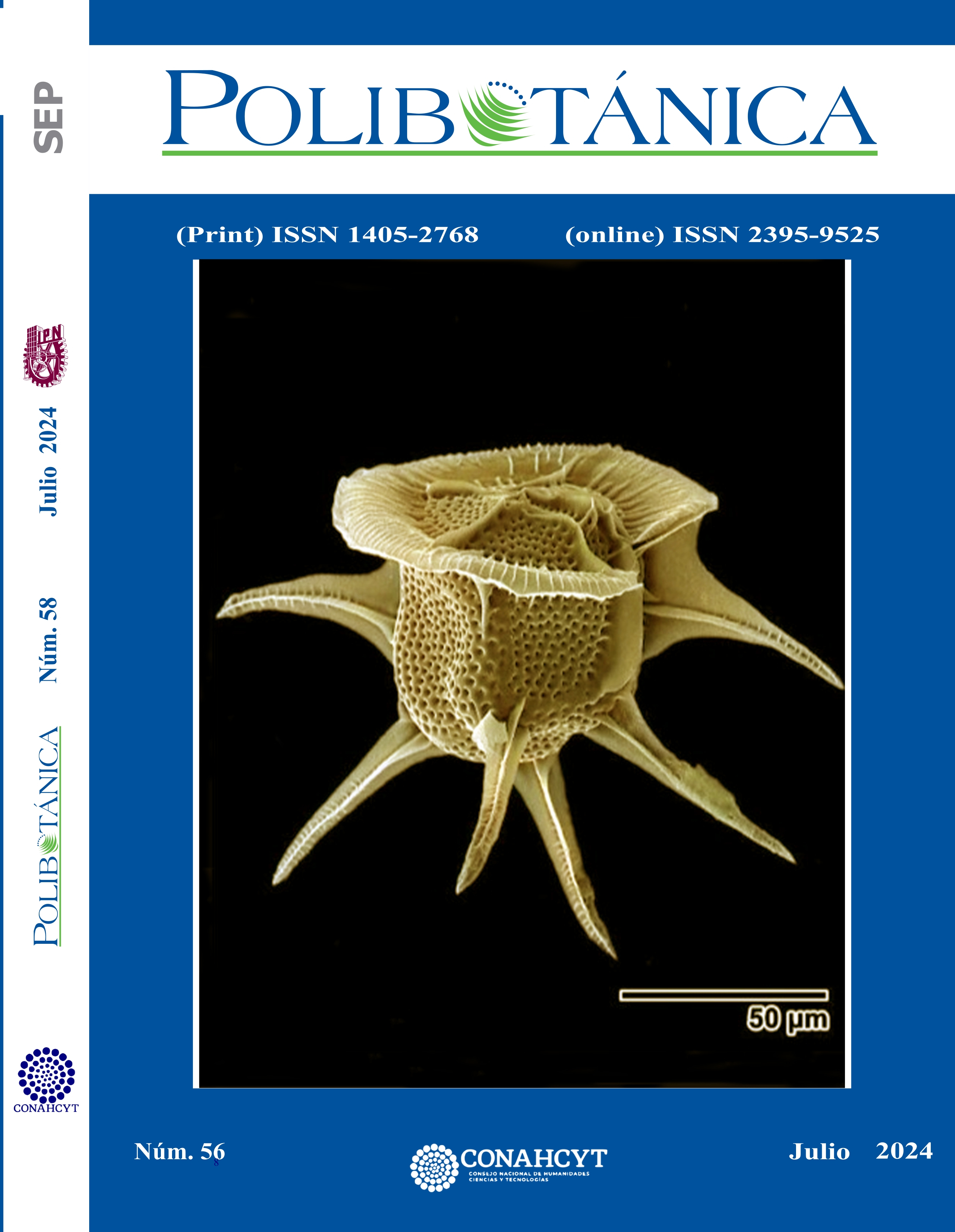The plant species known as camorreal in San Pedro el Alto, Oaxaca, Mexico
DOI:
https://doi.org/10.18387/polibotanica.58.18Keywords:
Medicinal plants, traditional knowledge, taxonomyAbstract
San Pedro El Alto is a community that belongs to the Zapotec ethnic group, it has a great biological wealth, its inhabitants have a great knowledge about the use of medicinal plants. The aim of the study was to taxonomically identify the species of plants known as “camorreal”, as well as their uses in the locality. The growth sites and the type of vegetation where they are found naturally were located, where botanical collections were made of the species that the inhabitants call “camorreal” indistinctly that were identified in the CHAPA Herbarium-Hortorium of the Colegio de Postgraduados, México. In addition, semi-structured interviews were conducted with 62 people from the community, to document the way in which they are used, and the criteria used to differentiate them. As results, five species of “camorreal” were identified: Asclepias circinalis, Asclepias melantha, Iostephane trilobata, Lobelia hartwegii and Psacalium paucicapitatum, all associated with pine-oak vegetation; Lobelia hartwegii is the most important species with local use for the inhabitants of the community.
References
Beltrán-Rodríguez, L., Ortiz-Sánchez, A., Mariano, N. A., Maldonado-Almanza, B., & Reyes-García, V. (2014). Factors affecting ethnobotanical knowledge in a mestizo community of the Sierra de Huautla Biosphere Reserve, Mexico. Journal of Ethnobiology and Ethnomedicine, 10(1). https://doi.org/10.1186/1746-4269-10-14.
Blancas, J., Pérez-Salicrup, D., & Casas, A. (2014). Evaluando la incertidumbre en la disponibilidad de recursos vegetales. In Gaia Scientia: Vol. Especial. http://periodicos.ufpb.br/ojs2/index.php/gaia/index.
Camou-Guerrero, A., Reyes-García, V., Martínez-Ramos, M., & Casas, A. (2008). Knowledge and use value of plant species in a rarámuri community: A gender perspective for conservation. Human Ecology, 36(2), 259–272. https://doi.org/10.1007/s10745-007-9152-3.
Casas, A., Otero-Arnaiz, A., Pérez-Negrón, E., & Valiente-Banuet, A. (2007). In situ management and domestication of plants in Mesoamerica. In Annals of Botany (Vol. 100, Issue 5, pp. 1101–1115). https://doi.org/10.1093/aob/mcm126.
Cruz Pérez, A. L., Barrera Ramos, J., Bernal Ramírez L. A., Bravo Avilez, D., & Rendón Aguilar, B. (2021). Actualized inventory of medicinal plants used in traditional medicine in Oaxaca, Mexico. In Journal of Ethnobiology and Ethnomedicine (Vol. 17, Issue 1). BioMed Central Ltd. https://doi.org/10.1186/s13002-020-00431-y.
Juárez-Jaimes, V., Rodríguez-Morales, L. O., Paniagua-Ibáñez, M., Hernández-Barón, G. M., & Fishbein, M. (2022). Diversity and distribution of the genus Asclepias (Apocynaceae: Asclepiadoideae) in México. Revista Mexicana de Biodiversidad, 93. https://doi.org/10.22201/IB.20078706E.2022.93.3958.
Martínez-López, G., Guízar Nolazco, E., Villanueva Morales, A., & Palacios-Rangel, M. I. (2021). Usos locales y tradición: estudio etnobotánico de plantas útiles en San Pablo Cuatro Venados (Valles Centrales, Oaxaca). Polibotánica, 0(52). https://doi.org/10.18387/polibotanica.52.13.
Muñetón Pérez, P. (2009). Plantas medicinales: un complemento vital para la salud de los mexicanos. Entrevista con el Dr. Erick Estrada Lugo. Revista Digital Universitaria, 10(9). http://www.revista.unam.mx/vol.10/num9/art58/int58.htm.
SEMARNAT. (2021). Plantas medicinales de México. https://www.gob.mx/semarnat/articulos/plantas-medicinales-de-mexico?idiom=es
Sen, T., & Samanta, S. K. (2014). Medicinal plants, human health and biodiversity: A broad review. Advances in Biochemical Engineering/Biotechnology, 147, 59–110. https://doi.org/10.1007/10_2014_273.
Sharma, V., & Sarkar, I. N. (2013). Leveraging biodiversity knowledge for potential phyto-therapeutic applications. Journal of the American Medical Informatics Association, 20(4), 668–679. https://doi.org/10.1136/amiajnl-2012-001445.
TIASA (Técnica Informática Aplicada S. A.). 1995. Programa de manejo forestal para la comunidad de San Pedro el Alto, Zimatlán de Álvarez, Oaxaca. México. 229 p
Toledo, V. M., Ortiz-Espejel, B., Cortés, L., Moguel, P., & De Jesús Ordoñez, M. (2003). The Multiple Use of Tropical Forests by Indigenous Peoples in Mexico: a Case of Adaptive Management. In Ecology (Vol. 7, Issue 3). https://www.jstor.org/stable/26271970.
Villaseñor, J. L. (2016). Catálogo de las plantas vasculares nativas de México. Revista Mexicana de Biodiversidad, 87(3), 559–902. https://doi.org/10.1016/j.rmb.2016.06.017.
Downloads
Published
Issue
Section
License

Polibotánica by Departamento de Botánica de la Escuela Nacional de Ciencias Biológicas del Instituto Politécnico Nacional se distribuye bajo una Licencia Creative Commons Atribución-NoComercial-CompartirIgual 4.0 Internacional.




















